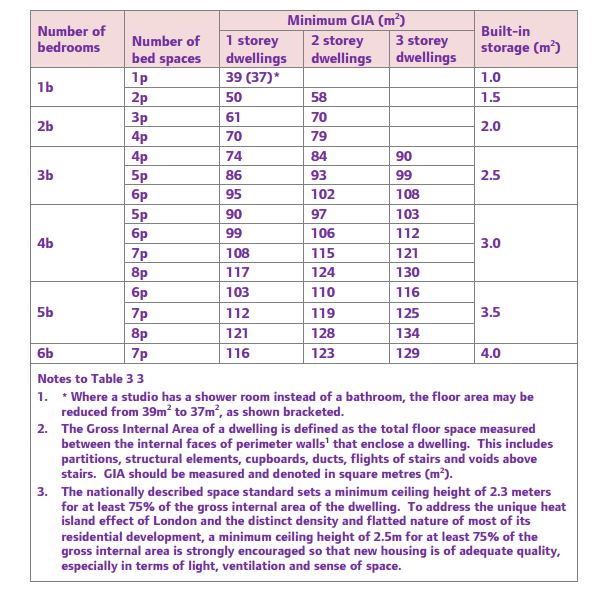The Gross Internal Area of a dwelling is defined as the total floor space measured between the internal faces of perimeter walls that enclose the dwelling. This includes partitions, structural elements, cupboards, ducts, flights of stairs and voids above stairs. The Gross Internal Area should be measured and denoted in square metres (m2).
The minimum size standards requires that:
a. the dwelling provides at least the gross internal floor area and built-in storage area set out in Table 1 below
b. a dwelling with two or more bedspaces has at least one double (or twin) bedroom
c. in order to provide one bedspace, a single bedroom has a floor area of at least 7.5m2 and is at least 2.15m wide
d. in order to provide two bedspaces, a double (or twin bedroom) has a floor area of at least 11.5m2
e. one double (or twin bedroom) is at least 2.75m wide and every other double (or twin) bedroom is at least 2.55m wide
f. any area with a headroom of less than 1.5m is not counted within the Gross Internal Area unless used solely for storage (if the area under the stairs is to be used for storage, assume a general floor area of 1m2 within the Gross Internal Area)
g. any other area that is used solely for storage and has a headroom of 900-1500mm (such as under eaves) is counted at 50% of its floor area, and any area lower than 900mm is not counted at all.
h. a built-in wardrobe counts towards the Gross Internal Area and bedroom floor area requirements, but should not reduce the effective width of the room below the minimum widths set out above. The built-in area in excess of 0.72m2 in a double bedroom and 0.36m2 in a single bedroom counts towards the built-in storage requirement
i. the minimum floor to ceiling height is 2.3m for at least 75% of the Gross Internal Area.

Please fill in the following form and one of our consultants will be in touch shortly...
 Message Us
Message Us